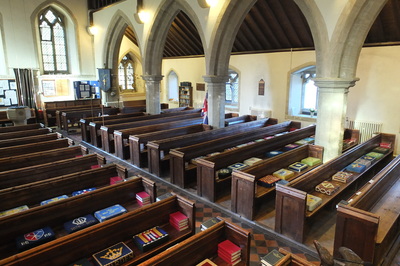
If you tip-toe into church late and let yourself down discretely onto the pew at the back by the bell pulls, the wooden seat gives out a creak like a kettle of banshees. Margaret and Derek Taylor, who lead our cleaning team, call it the ‘moaning pew’.
There are 27 pews in Holy Trinity, each one embedded into oak, and they are not identical. The one in the play area is made of oak, standing on legs crafted by Derek Taylor. No-one knows where it comes from: perhaps from another church. The rest are pine, which is less expensive, and individualised by woodworm, various half-identified fittings screwed into the sides, some of which have dropped out of use, and a bit of personal carving: for example, ‘P.J.’ gouged into one of the pews on the left at the back. An expert eye can see that the surfaces are wearing off and the wood needs stripping and revarnishing, though this is not for lack of care: Margaret Taylor’s cleaning team spray polishes every pew every week.
There is no record of when the pews were installed. Eighteen years after the church was consecrated in 1849, it was recorded to be practically devoid of ‘furniture’ but the records may have assumed the existence of pews and have been referring to a lack of cupboards, lectern, etc. The workmanship is undoubtedly Victorian: instead of screws, the wood is fitted together with wooden plugs (dowels). And take a look at the mouldings cut into the side panels.
The Holy Trinity pews are quite a tight squeeze (though there is more leg room in the back pews). The strips of edging on the shelf in front of each seat date from the 1990s: there was not room for proper book racks but these lips of wood allow some of the bits and pieces we rest in front of us not to be swept to the ground as we file out for communion.
Don’t take it for granted that Christian congregations have always been able to rest their backsides comfortably on a seat and lean back. It wasn’t always so. In fact, look at old paintings of Roman Catholic churches and all one is aware of is soaring Gothic overhead and sweeping vistas below. Not a seat in sight. Just a few small figures, as God might see us from on very high. In the Middle Ages, monks perched the edge of their bottoms on the small wooden shelves called misericords (‘mercy seats’) during the many hours of their offices. Other than dignitaries everyone else, presumably, stood.
There is a very good and practical reason why the early Church of England inaugurated permanent seating: so that congregations could survive long sermons without keeling over. It began with movable benches but, as comfort crept back in, these were replaced by fixed benches with backs: pews. ‘Take a pew,’ as Oxbridge scholars used to say.
Nor do all worshippers always sit in rows facing the altar but looking at the back of the person in front: Quakers sit in a circle, allowing the energy of prayer to pool in the space at the centre. Sometimes, people sit in the choir and face one another across the nave. These days, many churches have chairs. In the Eastern Church, people mill around in the empty spaces between door, walls, icons and the altar area, with seats only at the back for the infirm.
Seating was once a privilege and it was one that people paid for. Pews were rented, with free seating at the back for the hoi polloi: pew rental was a way of generating income and cashing in on the snobbery of those who sat closest to the sound of the Holy Writ (slumbering, perhaps, in comfort next to a portable heater and half hidden behind the high panels of their boxed pews). Mid 19th century reforms occasionally removed the pews in order to discourage renting.
Even before pews, congregations found ways of squabbling over seating. It was in 1287 that Bishop Quivilo complained: ‘We have also heard that the parishioners of divers places do oftentimes wrangle about their seats in church, two or more claiming the same seat; whence arises great scandal to the Church, and the divine offices are sore let and hindered: wherefore we decree that none shall henceforth call any seat in the church his own, save noblemen and patrons; but he who shall first enter, shall take his place where he will.’
Seats reserved for noblemen? Not in Quarry!
